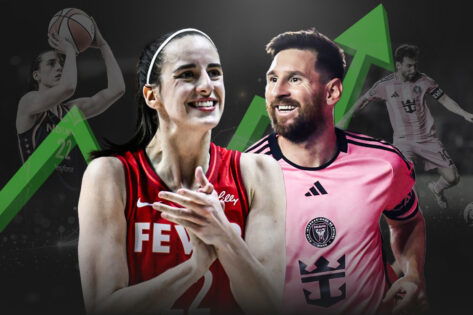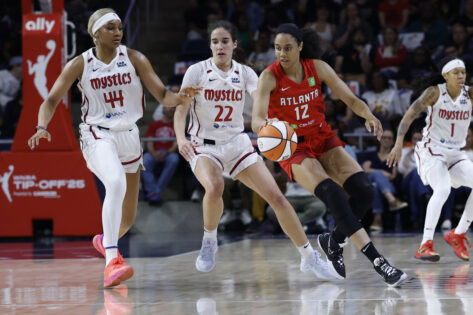Remember Botafogo – one of Brazil’s oldest and proudest football clubs? Just a few years ago, it was on life support: over R$1 billion ($180 million USD) in debt, crumbling infrastructure, and suffering its third relegation in ten years. But in 2022, U.S. tech entrepreneur John Textor stepped in, buying 80% of the club for just €7 million ($8.10 million). Fast forward to 2025: Botafogo revenues grew to over R$1.1 billion ($198 million). The turnaround was strategic, and Wall Street took notice.
For years, Wall Street played backup in sports, financing stadiums, dabbling in media, and helping billionaires buy teams. But that was then. Now, institutional investors are fully in the game. They no longer treat sports as a side bet but as a core asset class on par with real estate. Why? Because sports offer long-term, inflation-resistant value with global reach and cultural relevance. Leading this charge is Ares Management, a Wall Street-based investment firm overseeing more than $400 billion in assets.
And just recently, in 2025, Ares launched its $1.4 billion Sports, Media & Entertainment Fund II already 70% subscribed. Significantly, CalPERS, the largest U.S. public pension fund, committed $1 billion alone. Through this fund, Ares has built a global sports portfolio:
To start, Inter Miami CF -Ares invested a total of $225M (preferred equity): $150M in 2021, plus $75M more in 2023
ATP Media via CalPERS-backed funds
Elevate Sports Ventures through equity tied to Harris Blitzer Sports & Entertainment
Finally, Ares has indirect ownership (10%) in the Miami Dolphins and Hard Rock Stadium under new NFL PE rules
Ares also holds strategic stakes in:
Atletico de Madrid – 33.96% stake, valued at €181.8 million ($210.38 million).
Chelsea FC – Part of a $500m preferred equity round
Olympique Lyonnais – Backed the €900M ( $1 billion) + Eagle Football acquisition
McLaren Racing – Participated in a £550M ($730 M) funding round
SailGP Team France – In partnership with Kylian Mbappe’s group
How is Wall Street running the game now?
Wall Street actively reshapes how sports are run. Let’s look at what that’s already made possible:
That’s not all!
Secured a $450 million construction loan to fund Inter Miami’s stadium as part of the $1 billion Miami Freedom Park mixed-use project.
Content and scheduling strategies have evolved. MLS now capitalizes on Apple’s $2.5B, 10-year global streaming deal, removing blackouts and strategically slotting Messi’s games for peak global viewership.
At the same time, player development is getting a valuation upgrade. Inter Miami’s revamped youth academy, now led by Mascherano, treats young athletes not only as future stars but also as strategic growth assets in the club’s business model.
But does Wall Street’s $1.4 billion Sports, Media & Entertainment Fund II- led by Ares, mean it’s all just luck? Could it fail? Not quite.
Well, behind every Wall Street mind is a vision and a valuation model, and a strategy. Take a look at the heavyweights shaping this evolution:
Arctos Partners closed Fund II at over $4.1B, growing its sports AUM to $7B with stakes in the NBA, NHL, MLB, and Paris Saint-Germain.
Meanwhile, Sixth Street secured a €360M ($381M), 20-year agreement to manage Real Madrid’s Bernabéu Stadium business—marking a new era of financial oversight in elite sports venues.
RedBird Capital acquired AC Milan for €1.2B ($1.3B) in 2022, adding it to a portfolio that includes Fenway Sports Group and global media strategies.
Similarly, Liberty Media has transformed Formula 1 into a digital-first, global entertainment powerhouse.
CVC Capital has reshaped rugby and volleyball through structural investments and commercial governance control.
Nearly two-thirds of football club transactions in early 2025 involved U.S.-based buyers, including takeovers of Reading FC, Leyton Orient, Benfica stake investment, and more.
So, Wall Street is no longer sitting courtside; it’s building the arena. But with it, the question arises: Will leagues lose autonomy to investors?
Will Wall Street’s power come at the cost of league autonomy?
Not quite. However, the traditional model, where leagues govern and investors merely follow, is vanishing fast. With billions now at stake, financial giants hold real seats at the table. They’re co-authoring the playbook. Leagues may still wear the crown, but increasingly, Wall Street holds the scepter and the spreadsheet.
And the future? It’s already underway. Need proof?
Franchises like Angel City FC (valued at over $180M in 2024) and Bay FC show how women’s teams are now attracting serious capital. Meanwhile, the WNBA expects revenue to top $2.35B in 2025. That’s a 25% year-over-year increase, fueled by surging attendance, viewership, and a 601% spike in merchandise sales in 2024.
Beyond the U.S., global private equity firms and sovereign funds are actively scouting emerging markets like India and the Middle East, mirroring expansion trends seen in partnerships with European and North American leagues.
At the same time, sports leagues are partnering with OTT platforms for global distribution, integrating AI-powered fan data tools to personalize engagement, and using strategic scheduling to maximize global reach and monetization.
But the question arises: why is Wall Street is betting big on the WNBA, when women’s leagues have historically been undervalued?
Simple: the numbers are impossible to ignore, and the growth is real. Well, in 2024, WNBA viewership across ABC, CBS, and ESPN jumped 170%, in-person, attendance rose 48%, and merchandise sales skyrocketed by 601% year-over-year. Team valuations followed what used to be $10 million franchises in 2019 are now approaching $100 million, with teams like the Indiana Fever and Golden State Valkyries valued at $335M and $500M, respectively.
But here’s the thing: the WNBA is still massively undervalued compared to its male counterparts, which makes it an ideal entry point for investors looking for high potential returns. Unlike the NBA, the WNBA also allows full-court sponsorships, giving brands standout visibility beyond just jersey patches. And that visibility is translating into real value.
Take the Indiana Fever. Caitlin Clark’s arrival has generated $55.2M in sponsor media value and $233M in full media value. That’s nearly five times more than the next team, the NY Liberty, and represents 46% of the media value among the WNBA’s top 10 teams. In short, Wall Street sees what’s coming, and it’s not just a sports play.
What to monitor next:
Investors like Monarch Collective and Sixth Street are expanding their roster of women’s clubs across NWSL and WSL, signaling a wave of M&A activity in women’s football
Large pensions like Ontario Teachers’ (AUM $266B) are reconsidering full ownership strategies and shifting to partnerships, but they’ve previously fueled mega-deals, including MLSE for $1.3B, and hold sports rights like owning NBA Canada distribution.
New league models are emerging: like the proposed $5B global basketball league backed by LeBron James and Maverick Carter, or EPL/NWSL and MLS/NBA joint event strategies across men’s and women’s platforms under single ownership.
But now the question comes: Is this good for sports, or just good for capital? What do you think?
Undoubtedly, yes, Wall Street’s fingerprints are now all over the scoreboard. And that brings us to the tension at the heart of it all. On one side, capital injects scale, polish, and tech-forward innovation. It builds better stadiums, funds women’s leagues, and expands into emerging markets. But on the other side, what happens when ROI becomes the referee?
Could player development suffer under cost-benefit scrutiny? Might scheduling begin to favor streaming algorithms over tradition?
Do fans risk becoming mere “users,” as local loyalty gets diluted in global monetization models?
This is the new fault line: Is sport still for the people, or is it just another line item in a global portfolio?
The answer isn’t binary. But as more pension funds, PE giants, and sovereign investors enter the field, we all need to ask: Who’s really winning and what might get lost in the profit chase?
The post Wall Street’s Quiet Takeover of the Sports Industry and What Comes Next appeared first on EssentiallySports.



